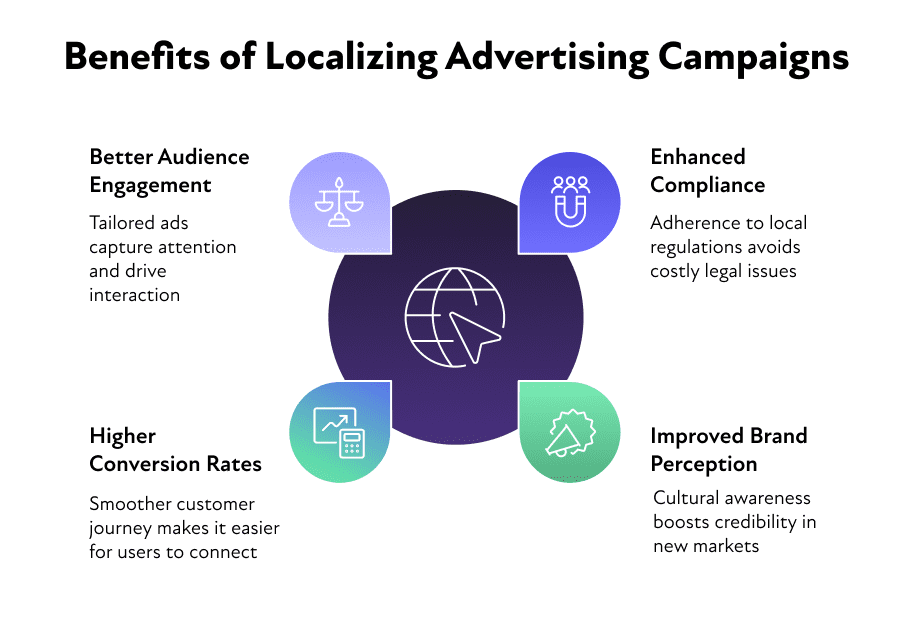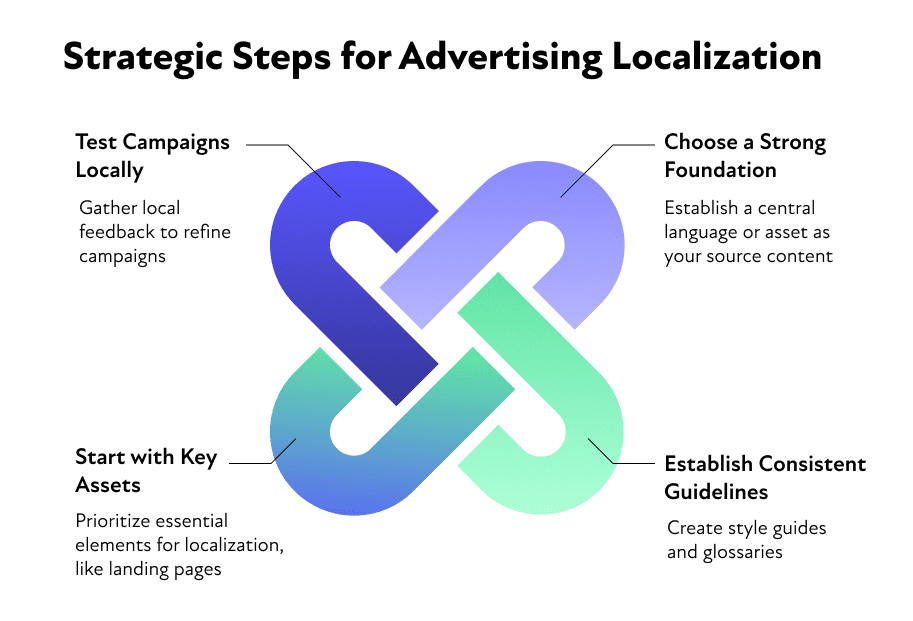Corinne Sharabi
Corinne is the Social Media and Content Lead at BLEND. She is dedicated to keeping global business professionals up to date on all things localization, translation, language and culture.


If you want to advertise globally, localization is essential. However, advertising localization isn’t as straightforward as word-for-word translation. To succeed as a truly international brand, you need a market-by-market approach that considers each region’s cultural norms, expectations, and nuances.
Launching advertising campaigns in multiple markets requires more than just translating content into different languages.
The truth is, nobody likes ads – so to make your campaigns effective, you need to treat every additional target market as if it were your home market.
This means rethinking and fully localizing each campaign to connect authentically with local audiences. The most successful ads are those that feel relevant and relatable, which often means tailoring the campaign significantly—or even creating entirely unique campaigns for specific markets.
Want to ensure your ads resonate globally? Let’s explore the core elements of advertising localization and how they can help your campaigns succeed.
Advertising localization involves adapting advertisement content from one locale to another. However, there’s more than a simple translation at work here. Everything from copy to the layout of an advertising campaign may need to be revised in order for marketing messages to connect with new audiences. As such, a full-scale localization strategy needs to be deployed, taking into account cultural references, language, tone, and imagery.
There are many reasons to prioritize advertising localization. For starters, it increases the odds of resonating with new audiences of consumers who prefer local products and marketing messaging that speak their language. Adapting advertising content to local language requirements, user sentiment, seasonal trends, and even major events like international holidays 2025 can help you better provide for a target audience.
Localization plays a critical role in the success of advertising campaigns when entering new markets. It helps brands avoid potential missteps, such as using imagery or messaging that may unintentionally offend or overlook cultural nuances. Additionally, localization ensures clarity in taglines, where conveying a powerful message in just a few words can be incredibly challenging. By adapting these elements effectively, localization enhances the impact of your campaigns.
However, language is just the beginning. Effective advertising localization goes beyond translation to incorporate local culture, history, and values, fostering a genuine emotional connection with the audience. It also helps maintain brand consistency across multiple regions. While certain elements may need to be adapted, localization allows you to deliver your core message without compromising your brand identity.

There are many reasons to invest in advertising localization. For one, it can help improve audience engagement. Native users are far more likely to engage with content when it feels as though it’s been made specifically with them in mind, rather than translated from another language.
Localization can also improve brand perception in markets. This is crucial if you’re entering into a new territory as a new commodity and even more crucial if you’re operating in a crowded market.
All of this results in more clicks and higher conversion rates, helping protect the bottom line and aid future expansion efforts. In addition, localization ensures your campaigns adhere to local regulations, avoiding costly legal issues or reputational damage.
By treating each market as a unique opportunity rather than an extension of your original campaign, you can build trust and drive results.
Eager to make a success of advertising localization? Below, we’ll take a closer look at some of the most important steps to bear in mind when localizing advertising for international markets.
To succeed at advertising localization, you need to have a firm grasp of who your target audience is. This should be established during the market research stage. You’ll need insights into customer demographics, including metrics like age and exact location. However, you should really be looking deeper than these surface-level metrics.
In addition, you’ll need a solid understanding of cultural nuances, colloquialisms, and other region-specific details. What’s more, you’ll need insights into buyer preferences to ensure you’re creating advertising content that’s striking the right note with audiences.
Adapting visual and written content is one of the most important aspects of advertising localization. It’s also one of the most difficult elements to get right. Rather than go at things with a translation mindset, a transcreation approach is a far safer bet. A slightly looser approach will allow you to make all the changes you need to create content that’s better aligned with audience expectations and more likely to resonate with them.
While all copy elements will need to be localized, some are more important than others. Things like tag lines are what really sell a product, so these need to be prioritized. While you might be keen to preserve the sentiment of an original message exactly, this isn’t always possible. Tag lines, especially those that deploy humor, rarely translate easily. Therefore, you may need to rethink this integral part of your advertising campaign.
Localizing imagery is another time-intensive and tricky task. To make life easier, establish rules surrounding imagery based on the insights you’ve gathered from your market research. Avoid causing offense in new territories by paying attention to which images are deemed culturally inappropriate in that locale. Some cultures prefer a more diverse approach, while others favor a more homogeneous one. A particular color might be suitable in one country, but entirely inappropriate somewhere else.
Effective localization hinges on using local experts with the right level of insight into your target market. Although regular translators can be used to support localization projects, it’s best to bring in the services of experienced marketing and advertising localization linguists. These experts better understand the requirements of advertising localization projects and can help you create culturally nuanced and relevant content that resonates. With BLEND, for example, you can request translators with expertise in marketing and advertising, ensuring your campaigns benefit from industry-specific knowledge.
Ensure you’re always working with linguists who speak target languages at a native level. It’s also a good idea to encourage open lines of communication, with linguists able to freely share ideas.

Time and budget constraints often challenge localization efforts. While automation tools can speed up translation, over-reliance on them risks producing campaigns that feel impersonal or miss cultural nuances entirely.
Another common issue is failing to account for regional variations within the same language. Take Spanish as an example. An official language in 21 countries, Spanish has more than 10 unique dialects. If you want to access every Spanish speaker with an advertising campaign, you’ll need to adopt a multi-pronged approach to localization. Tailoring your campaign for specific dialects ensures your message resonates authentically.
Finally, not every campaign is suitable for every market. As part of your strategy, identify which campaigns will translate well and which may need to be replaced entirely for specific regions.
Localizing advertising doesn’t have to be difficult. By following a few best practices, it’s easier to make a success of things. Firstly, you’ll need to decide on your source material, which is typically written in English in many parts of the world, including Asia and Europe.
Next, you’ll need to decide on what your central assets are. Many things fall under the banner of key assets, including everything from logos to color palettes. Ideally, you should aim to lock these down as early as possible to ensure consistency across the board. It’s also worth investing the time in creating terminology glossaries and style guides to better guide your localization team.
You may also need to adapt advertising formats. In some countries, product-specific imagery is the standard, while vague imagery that evokes emotions is the preference elsewhere. What’s more, some audiences favor text over imagery. You’ll be able to establish what works for your target audience when carrying out market research.
Another useful thing to remember is to localize your most important assets first. You’ll want to prioritize your homepage and landing pages that generate most of your leads. Other important assets include FAQ sections and help centers.


Many brands have excelled at advertising localization by tailoring their campaigns for specific markets.
Clothing retailer H&M is one example of a brand that’s managed to nail advertising localization. When expanding into the Netherlands with the unveiling of its Amsterdam store, H&M delivered a truly localized advertising campaign that celebrated the culture and diversity of its target city. The ad content also considered regional-specific interests and lifestyle specifics, including a keen concern for environmental issues and sustainability.
Nike is another company that excels when it comes to advertising localization. Today, the footwear and sportswear brand is active in 170 countries, with each market enjoying targeted advertising campaigns. Known for its use of local celebrities, Nike’s advertisements feature recognizable faces from each market. Their ads also capture the essence of locations with instantly recognizable landmarks and locations.
If you’re looking to create captivating advertising content that strikes a chord with native audiences in new markets, localization is a must. By undertaking a well-designed and executed localization strategy, you can ensure you’re delivering advertising content that feels like it was produced with native customers in mind.
First time localizing advertising material for a new market? Turn to an experienced localization services partner like BLEND to make quick work of your expansion efforts. Offering industry-leading insights and innovative tools and software, we’ll help you reach your audience in every language.
Ready to learn more about how BLEND can help you achieve your global expansion goals? Get in touch with the team today.
What our customers are saying